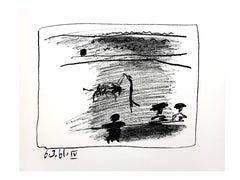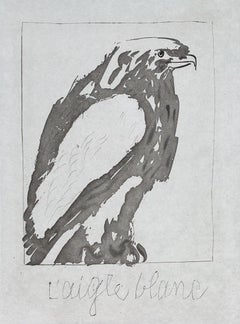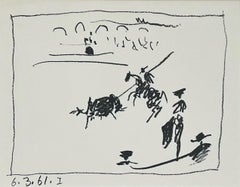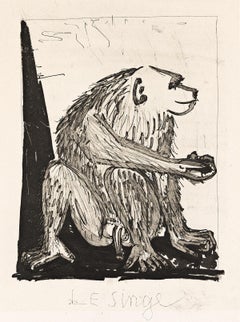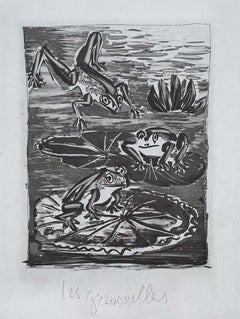Pablo Picasso Animal Prints
One of the most prolific and revolutionary artists the world has ever seen, Pablo Picasso had a tremendous impact on the development of 20th-century modern art. Although he is best known for his association with the Cubist movement, which he founded with Georges Braque, Picasso’s influence extends to Surrealism, neoclassicism and Expressionism.
“Every act of creation is, first of all, an act of destruction,” the Spanish artist proclaimed. In Picasso's Cubist paintings, he emphasizes the two-dimensionality of the canvas, breaking with conventions regarding perspective, foreshortening and proportion. Picasso was inspired by Iberian and African tribal art. One of his most famous pre-Cubist works is Les Demoiselles d’Avignon (1907), a painting considered immoral and shocking at the time for its depiction of nude women whose faces resemble Iberian tribal masks.
Picasso made many portraits in this style, most often of the women in his life, their expressively colored faces composed of geometric shards of surface planes. In Woman in a Hat (Olga), 1935, he painted his first wife as an assemblage of abstract forms, leaving the viewer to decipher the subject through the contrasting colors and shapes. Picasso was a tireless artist, creating more than 20,000 paintings, drawings, prints, ceramics and sculptures. Tracing his life’s work reveals the progression of modern art, on which he had an unparalleled influence.
Browse an expansive collection of Pablo Picasso's art on 1stDibs.
1950s Modern Pablo Picasso Animal Prints
Ceramic
1960s Modern Pablo Picasso Animal Prints
Lithograph
20th Century Modern Pablo Picasso Animal Prints
Drypoint, Aquatint
1960s Cubist Pablo Picasso Animal Prints
Lithograph
1930s Modern Pablo Picasso Animal Prints
Drypoint, Aquatint, Etching
20th Century Modern Pablo Picasso Animal Prints
Drypoint, Aquatint
20th Century Modern Pablo Picasso Animal Prints
Drypoint, Aquatint
20th Century Modern Pablo Picasso Animal Prints
Drypoint, Aquatint
20th Century Modern Pablo Picasso Animal Prints
Drypoint, Aquatint
20th Century Modern Pablo Picasso Animal Prints
Aquatint, Drypoint
1940s Cubist Pablo Picasso Animal Prints
Etching, Paper
20th Century Modern Pablo Picasso Animal Prints
Aquatint, Drypoint
20th Century Modern Pablo Picasso Animal Prints
Aquatint, Drypoint
20th Century Modern Pablo Picasso Animal Prints
Aquatint, Drypoint
20th Century Modern Pablo Picasso Animal Prints
Drypoint, Aquatint
20th Century Modern Pablo Picasso Animal Prints
Drypoint, Aquatint
20th Century Modern Pablo Picasso Animal Prints
Aquatint, Drypoint
20th Century Modern Pablo Picasso Animal Prints
Drypoint, Aquatint
20th Century Modern Pablo Picasso Animal Prints
Aquatint, Drypoint
20th Century Modern Pablo Picasso Animal Prints
Drypoint, Aquatint
20th Century Modern Pablo Picasso Animal Prints
Drypoint, Aquatint
20th Century Modern Pablo Picasso Animal Prints
Aquatint, Drypoint
20th Century Modern Pablo Picasso Animal Prints
Drypoint, Aquatint
1950s French School Pablo Picasso Animal Prints
Lithograph
1960s Cubist Pablo Picasso Animal Prints
Paper, Engraving
1950s Pablo Picasso Animal Prints
Aquatint
1950s Modern Pablo Picasso Animal Prints
Lithograph
1960s Cubist Pablo Picasso Animal Prints
Lithograph
1960s Pablo Picasso Animal Prints
Lithograph
1960s Pablo Picasso Animal Prints
Lithograph
1930s Cubist Pablo Picasso Animal Prints
Drypoint, Paper, Aquatint, Engraving
1960s Modern Pablo Picasso Animal Prints
Lithograph
1960s Cubist Pablo Picasso Animal Prints
Linocut, Paper
1940s Minimalist Pablo Picasso Animal Prints
Etching
1950s Pablo Picasso Animal Prints
Aquatint
1940s Abstract Pablo Picasso Animal Prints
Ceramic, Earthenware
1930s Cubist Pablo Picasso Animal Prints
Paper, Engraving
1960s Modern Pablo Picasso Animal Prints
Lithograph
1960s Pablo Picasso Animal Prints
Lithograph
1960s Abstract Pablo Picasso Animal Prints
Lithograph
Pablo Picasso animal prints for sale on 1stDibs.
Artists Similar to Pablo Picasso
- Who is Pablo Picasso?1 Answer1stDibs ExpertMarch 22, 2022Pablo Picasso was one of the most influential artists of the 20th century. He helped pioneer the style of Cubism, which involves depicting objects in fragmented geometric shapes. His works served as inspiration for future abstract art movements. You'll find a large selection of Pablo Picasso art on 1stDibs.
- Where is Pablo Picasso from?1 Answer1stDibs ExpertMarch 22, 2022Pablo Picasso was from Spain. He was born in Málaga, Spain, on October 25, 1881. He later moved to France, the country where he completed most of his work. Picasso died in Mougins, France, on April 8, 1973. On 1stDibs, find a large selection of Pablo Picasso art.
- What is Pablo Picasso known for?1 Answer1stDibs ExpertMarch 22, 2022Pablo Picasso is best known for Cubism. He was one of the dominant artists of the movement. Cubism is a form of abstract art that focuses on showing objects and individuals as fragmented geometric shapes. It marked a radical shift from other art movements that came before it. On 1stDibs, find a variety of Pablo Picasso art.
- 1stDibs ExpertApril 5, 2022Yes, Pablo Picasso made prints throughout his career. His first was made in 1899 when he was still a teen, and his final one was made in 1972 when the artist was 90 years old. It’s estimated that he produced around 2400 prints in his lifetime. Shop a selection of Pablo Picasso pieces from some of the world’s top art dealers on 1stDibs.
- 1stDibs ExpertFebruary 22, 2021Pablo Picasso is most famous for founding the Cubist movement, which uses several points of view and perspectives, creating a geometric-looking result. Cubism was considered a massive break from traditional methods of painting. One of Picasso's most famous cubist pieces is “Guernica,” the artist's representation of the Spanish Civil War.
- When was Pablo Picasso born?1 Answer1stDibs ExpertMarch 22, 2022Pablo Picasso was born on October 25, 1881 in Málaga, Spain. However, he spent most of his working years in France and lived there until he died in the commune of Mougins on April 8, 1973. On 1stDibs, find a large collection of Pablo Picasso.
- What inspired Pablo Picasso?1 Answer1stDibs ExpertMarch 22, 2022The Spanish artist El Greco inspired Pablo Picasso's early work. As his interest in abstraction grew, Picasso turned to African masks and handicrafts for inspiration. The works of Paul Cézanne and Henri Rousseau also influenced the artist. Find a selection of Pablo Picasso art on 1stDibs.
- Where did Pablo Picasso live?1 Answer1stDibs ExpertMarch 22, 2022Although born in Spain, Pablo Picasso lived in France while working as an artist. From 1904 to 1946, he called Paris home. Then, he relocated to the South of France. He died there in the commune of Mougins on April 8, 1973 at the age of 91. Shop a large selection of Pablo Picasso art on 1stDibs.
- Where was Pablo Picasso born?1 Answer1stDibs ExpertMarch 22, 2022Pablo Picasso was born in Málaga, Spain. His birth date is October 25, 1881. In 1891, Picasso's family moved to A Coruña, Spain, so that his father, Don José Ruiz y Blasco, could work as a professor at the School of Fine Arts. When Picasso became an artist, he relocated to France, where he lived until he died on April 8, 1973. Find a large collection of Pablo Picasso art on 1stDibs.
- 1stDibs ExpertApril 5, 2022To draw, Pablo Picasso used a wide variety of implements. Specifically, he drew with pencils, pens, charcoal, ink, chalk and pastels. What materials he reached for depended on what he was depicting and what was readily available. Find a selection of Pablo Picasso art on 1stDibs.
- Did Pablo Picasso make ceramics?1 Answer1stDibs ExpertApril 5, 2022Yes, Pablo Picasso did indeed make ceramics. He started working with clay in the later years of his life as a sort of escapism from the heavy demands of painting. Shop a selection of Pablo Picasso pieces from some of the world’s top art dealers on 1stDibs.
- 1stDibs ExpertMarch 22, 2022Pablo Picasso began painting as a child. His father gave him art lessons starting at age 7. The earliest painting attributed to the artist is Le Picador. He painted the piece in 1890 when he was just 9 years old. You'll find a range of Pablo Picasso art on 1stDibs.
- 1stDibs ExpertMarch 13, 2024Although his work evolved over time, Pablo Picasso's art style is typically associated most with Cubism. Picasso helped establish the art movement along with his contemporary, Georges Braque. The Spanish artist's work also influenced Surrealism, neoclassicism and Expressionism. Explore a diverse assortment of Pablo Picasso art from some of the world's top galleries and dealers on 1stDibs.
- Did Pablo Picasso go to school?1 Answer1stDibs ExpertMarch 22, 2022Yes, Pablo Picasso went to school. He was a student at the Real Academia de Bellas Artes de San Fernando in Madrid, Spain. When he began his studies in 1897, the academy was the top art school in the country. Picasso did not finish his studies, however. Instead, he traveled to Paris in 1900 and began working as an artist. On 1stDibs, find a collection of Pablo Picasso art.
- 1stDibs ExpertMarch 22, 2022Pablo Picasso was 91 years old when he died on April 8, 1973, in Mougins, France. His 92nd birthday would have been on October 25 of that year. You can shop a large collection of Pablo Picasso art on 1stDibs.
- 1stDibs ExpertMarch 22, 2022Historians disagree about which of Pablo Picasso's paintings is the most famous because many of his works are well-known and easily recognizable. Some notable pieces include Guernica, Les Demoiselles d'Avignon, The Old Guitarist, The Weeping Woman and Portrait of Ambroise Vollard. You'll find a large collection of Pablo Picasso on 1stDibs.
- 1stDibs ExpertMarch 22, 2022Pablo Picasso's full name was Pablo Diego José Francisco de Paula Juan Nepomuceno María de los Remedios Cipriano de la Santísima Trinidad Ruiz y Picasso. He shortened it to Pablo Ruiz Picasso, but most people refer to him as "Pablo Picasso" or simply "Picasso." Shop a wide range of Pablo Picasso art on 1stDibs.
- 1stDibs ExpertApril 5, 2022There is no general consensus about which of Pablo Picasso's works is his most famous drawing. Some of his most well-known works depict animals and include Dog, Penguin, Camel, Butterfly, Owl and Dove of Peace. Find a selection of Pablo Picasso art on 1stDibs.
- 1stDibs ExpertApril 5, 2022Guernica is arguably amongst Pablo Picasso’s best works, and is an incredibly moving anti-war statement. The piece was originally commissioned as a mural for the 1937 World Fair in Paris, France. Shop a selection of Pablo Picasso pieces from some of the world’s top art dealers on 1stDibs.
- 1stDibs ExpertFebruary 1, 2024One interesting fact about Pablo Picasso is that the artist was extremely prolific, producing more than 150,000 works during the course of his life. Although known by just “Picasso,” his full name is actually 35 words long: Pablo Diego José Francisco de Paula Juan Nepomuceno María de los Remedios Cipriano de la Santísima Trinidad Martyr Patricio Clito Ruíz y Picasso. Police once thought he was responsible for stealing the Mona Lisa, and ironically, more Picasso paintings have been reported as missing or stolen than those of any other artist in history. Before he died at the age of 91, Picasso reportedly said, "Drink to me, drink to my health, you know I can't drink anymore," and his parting words inspired Paul McCartney to write the song "Picasso's Last Words (Drink to Me)." On 1stDibs, find a selection of Pablo Picasso art.

